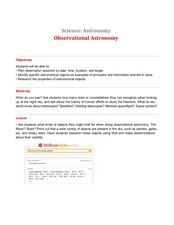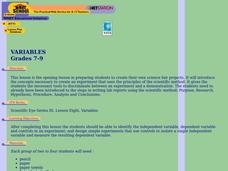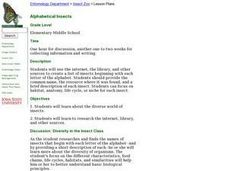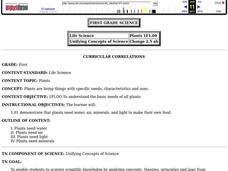Curated OER
Aging of Trees
Students examine tree rings to determine its age. In this tree ring lesson, students examine core tree samples, identify the tree rings, and then determine its age. Students complete a worksheet, deciding which of the two core...
Curated OER
Observational Astronomy
Students research about the characteristics of celestial bodies using a database. In this space science lesson, students collect data such as brightness, apparent color and size by observing the night sky. They share their findings with...
Curated OER
Constitutional Issues: The Separation of Powers
Students research and stage a debate on the question: RESOLVED that the Constitution should be amended to provide for a parliamentary system of government. They debate if a parliamentary system of government might be better.
Curated OER
Tree Leaves: Determining the Characteristics They Share in Common
Students use their basic knowledge of dendrology concepts and terms. In this tree leaf lesson students divide into groups and determine which characteristics go with what plant.
Curated OER
Hot Stuff
Students investigate if heat can change the form of matter. In this physics lesson, students use heat sources to observe the changes in an ice cube. Students graph which heat source changed the matter the fastest.
Curated OER
Writing Newspaper Articles
Students write newspaper articles regarding their service learning experiences. In this writing skills lesson, students review the writing process skills to develop high-quality articles. Students write articles regarding the their acts...
Alabama Learning Exchange
It's Around There Somewhere! Perimeter, and Circumference
Explore the concept of building equations for perimeter and circumference. Learners use rulers to measure the perimeter of half a sheet of paper. Then fold the sheet of paper numerous times, each time measuring perimeter. ...
Curated OER
The Great Cover Up!
Students use non-standard measurement tools such as body parts, beans and counters to find the area of shapes drawn on the floor. They continue to determine the area of other objects in the classroom.
Curated OER
Probability: the Study of Chance
Students experiment to determine if a game is fair, collect data, interpret data, display data, and state and apply the rule for probability. Students use a simple game for this experiment.
Curated OER
Variables
Pupils watch a video show how to identify the independent variable, dependent variable and controls in an experiment; and design experiments that use controls to isolate a single independent variable and measure the resulting dependent...
Curated OER
Test Your Reading Skills: Cloze Activity
In this reading comprehension cloze learning exercise, learners are instructed to fill in blanks with any word or phrase that "fits." The paragraph is about a shopping trip. Possible answers are given.
Curated OER
Mars Calendar Project
Students design a calendar that displays time on Mars. They explore the differences between time on Earth and time on Mars while making the calendar.
Curated OER
Investigation 3 - What is Moonlight?
Third graders observe a demonstration explaining that the moon reflects sunlight in ordr to shine.
Curated OER
Disguise! Disguise!
Third graders explore how some animals disguise or camouflage themselves as a form of protection.
Curated OER
How Does Climate Affect Your Environment?
Students access the Global Sun Temperature Project website and research the relationship between the location and climate of a participating school to its building structure. They consider how climate affects the type of structures...
Curated OER
Interior Designer for a Day
Seventh graders organize a 20 x 17 room with a given set of furniture pieces. Arrangement is to be based on maximum comfort and practicality. This lesson is a good way to teach and reinforce the mathematical concept of area.
Curated OER
Alphabetical Insects
Students research using the internet, the library, and other sources to create a list of insects beginning with each letter of the alphabet. They provide the common name, the resource where it was found, and a brief description of each...
Curated OER
Greenhouse Effect
Young scholars identify greenhouse gases. They explain why perfluorocarbons are a bad alternative to chlorofluorcarbons. They determine both the least and most influential greenhouse gases.
Curated OER
How Do I Get a Pure Sample of the Molecules I Make?
Students initially engage in online research and consult print materials to identify a compound to produce. Once a selection has been made, individually, students conduct lab experiments to isolate substances. The end product is a...
Curated OER
Got The Beat
Students listen to song in which they identify the beat. Listening to the song again, they clap and march to the beat after being introduced to the new vocabulary. They complete the same exercises for other songs played in class.
Curated OER
Plants
First graders explore the specific needs, characteristics, and uses of plants. They discuss the needs of plants as they grow. Students observe plants in various settings as they grow and note the changes they see.
Curated OER
Itchy Iggy
First graders observe the letter /i/ and the sound that it makes watching their mouths as the sound is formed. They say the tongue twister displayed repeating it three times; the last time they stretch out the /i/ sound as it occurs in...
Curated OER
Science: Testing Water for Toxicity
Learners investigate the potential toxicity of water samples using California blackworms to test water quality. They observe the worms' behaviors in different water samples and determine which sample has the highest toxicity. At the...
Other popular searches
- Fundamental Counting Principle
- Games Counting Principle
- Algebra Counting Principle
- Counting Principle Model
- The Counting Principle
- Addition Counting Principles
- Fundemental Counting Principle
- Math Counting Principle
- Rational Counting Principles
- Counting Principle Probability
- Basic Counting Principle Math























